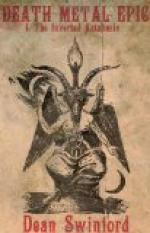Not content with an epic apiece, Barlow and Trumbull, with several other “Hartford wits,” joined forces in composing the Anarchiad, which exercised considerable influence on the politics of its time.
In 1819 appeared Washington Irving’s Sketch-Book, which contains the two classics, Legend of the Sleepy Hollow, and Rip Van Winkle, which are sometimes quoted as inimitable samples of local epics in prose. Cooper’s Leather-stocking series of novels, including the Deerslayer, The Last of the Mohicans, The Pathfinder, The Pioneers, and The Prairie, are also often designated as “prose epics of the Indian as he was in Cooper’s imagination,” while some of his sea-stories, such as The Pirate, have been dubbed “epics of the sea.” Bryant, first-born of our famous group of nineteenth-century American poets, made use of many of the Indian myths and legends in his verse. But he rendered his greatest service to epic poetry by his translations of the Iliad and the Odyssey, accomplished when already eighty years of age.
There are sundry famous American heroic odes or poems which contain epic lines, such as Halleck’s Marco Bozzaris, Dana’s Buccaneers, Lowell’s Vision of Sir Launfal, and Biglow Papers, Whittier’s Mogg Megone, Holmes’s Grandmother’s Story of Bunker Hill Battle, Taylor’s Amram’s Wooing, Emerson’s Concord Hymn, etc., etc. Then, too, some critics rank as prose epics Hawthorne’s Scarlet Letter, Poe’s Fall of the House of Usher, Hale’s Man Without a Country, Bret Harte’s Luck of Roaring Camp, Helen Hunt Jackson’s Ramona, etc., etc.
It is, however, Longfellow, America’s most popular poet, who has written the nearest approach to a real epic, and the poems most likely to live, in his Wreck of the Hesperus, Skeleton in Armor, Golden Legend, Hiawatha, Tales of a Wayside Inn, Courtship of Miles Standish, and Evangeline, besides translating Dante’s grand epic The Divine Comedy.
In Longfellow’s Wreck of the Hesperus we have a miniature nautical epic, in the Skeleton in Armor our only epic relating to the Norse discovery, in the Golden Legend, and in many of the Tales of a Wayside Inn, happy adaptations of mediaeval epics or romances.
Hiawatha, often termed “the Indian Edda,” is written in the metre of the old Finnish Kalevala, and contains the essence of many Indian legends, together with charming descriptions of the woods, the waters, and their furry, feathered, and finny denizens. Every one has followed entranced the career of Hiawatha, from birth to childhood and boyhood, watched with awe his painful initiation to manhood and with tender sympathy his idyllic wooing of Minnehaha and their characteristic wedding festivities. Innumerable youthful hearts have swelled at his anguish during the Famine, and countless tears have silently dropped at the death of the sweet little Indian squaw. After connecting this Indian legend with the coming of the White Man from the East, the poet, knowing the Red man had to withdraw before the new-comer skilfully made use of a sun-myth, and allowed us to witness Hiawatha’s departure, full of allegorical significance:




